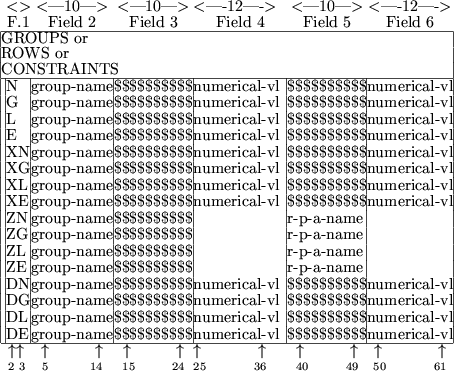 |
The GROUPS, ROWS and CONSTRAINTS indicator cards are used interchangeably to announce the names of the groups which make up the objective function and, for constrained problems, the names of the constraints (or rows, as they are often known in linear programming applications). In addition, the entries for the linear elements are input here. The user may give a scaling factor for the groups or constraints. Furthermore, groups which are linear combinations of previous groups may be specified. The syntax for the data cards which follow these indicator cards is given in Figure 3.10.
The one- or two-character string in data field 1 specifies the type of group, row or constraint to be input. Possible values for the first character and their interpretations are exactly as in Section 3.2.6.
The string group-name in data field 2 gives the name of the group (or row or constraint) under consideration. This name may be up to ten characters long excepting that the name `SCALE' is not allowed. For X and Z data cards, the expanded array name must be valid and the integer indices must have been defined in a parameter assignment (see Section 3.2.3). The kind of group (N, L, G or E) will be taken to be that which is defined on the first occurrence of a data card for that group. Subsequent contradictory information will be ignored.
The string $$$$$$$$$$ in data field 3 is used for three purposes.
In these first two cases, fields 5 and 6 may be used to define further coefficients or a scale factor for non Z cards.
